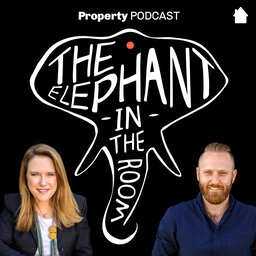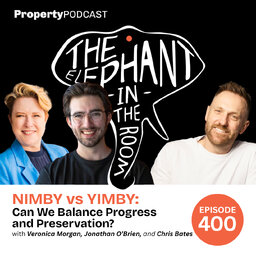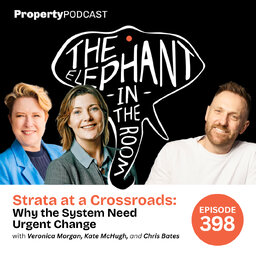Are Conflicting Data Points Sabotaging Your Property Investment Choices?
The allure of data in property investment is undeniable, but it's not a one-size-fits-all solution. As we delve into this episode, we'll explore the critical issue of conflicting data points. We often assume data is an infallible foundation for decision-making, but it's how we interpret and contextualise that data that truly matters. What happens when the same dataset tells multiple, even contradictory stories? How do you know which information to trust when making one of the most significant financial decisions of your life?
In this episode, we are joined by Jeremy Sheppard, a property data specialist with a passion for uncovering the secrets of great capital growth locations. Back in 2010, Jeremy created the Demand to Supply Ratio (DSR), a groundbreaking predictor of capital growth that has since become a cornerstone for many investors. But Jeremy's journey isn't just about success; it's about the lessons learned through experience. As he puts it, "I think I've made all the mistakes I can for now. From here, it's all about helping other investors avoid the mistakes I made."
Join us today as we tackle a topic that's on the minds of every savvy investor: capital growth. What's the secret to achieving it, how should it be measured, and over what time frame? We answer the most common questions that have perplexed investors for years, and it's time to demystify them. So tune in now and equip yourself with the knowledge you need to make confident, lucrative property investment decisions.
Episode Highlights:
00:00 - Introduction
01:12 - Who is Jeremy Sheppard?
02:11 - Common mistakes Jeremy experienced and thinks property investors should avoid
04:28 - What are the key takeaways for successful property investment structuring?
08:10 - How Jeremy got into the property data space
12:45 - Understanding the fundamentals of the property market
16:32 - What is the minimum return needed for a short-term investment to be a good bet?
20:17 - How DSR helps in determining when and where to buy and sell a property
26:25 - Metrics and factors to consider when assessing the desirability and potential of a suburb
33:08 - What is the ripple effect of population growth on suburbs?
36:47 - Is it right to use income growth alone as a predictor of property price growth?
38:32 - What are the limitations of using census data for property price growth predictions?
43:06 - Is there a direct correlation between income growth and capital growth in real estate?
46:38 - Potential shortcomings of analysing property market data over a single timeframe
50:44 - Can increased investor activity be a predictive metric for property markets?
54:36 - Is there a middle ground between active and passive property investment?
57:54 - The importance of timing and the factors that influence property purchases
About Our Guest:
Jeremy Sheppard is a seasoned property investor and data expert who began his real estate journey in 2002, accumulating 15 properties over six years and learning from his experiences. His passion lies in leveraging property data to identify capital growth opportunities, culminating in the creation of the Demand to Supply Ratio (DSR) in 2010 and the launch of dsrdata.com.au in 2015. Jeremy has shared his expertise through 50+ articles for publications like Your Investment Property magazine and appearances on popular property podcasts, as well as on television programs like Sunrise. His extensive knowledge of property data and capital growth makes him a trusted authority in the field, driven by a mission to help fellow investors succeed.
Connect with Jeremy Sheppard:
- Visit Jeremy’s website: https://dsrdata.com.au/
- Follow Jeremy on LinkedIn: https://www.linkedin.com/in/jeremy-sheppard-463344b8/
Resources mentioned in this episode:
- How to Lie with Statistics by Darrell Huff https://www.amazon.com.au/How-Lie-Statistics-Darrell-Huff/dp/0393310728
Resources:
- Visit our website https://www.theelephantintheroom.com.au
- If you have any questions or would like to be featured on our show, contact us at: The Elephant in the Room Property Podcast questions@theelephantintheroom.com.au
- Looking for a Sydney Buyers Agent? https://www.gooddeeds.com.au
- Work with Veronica: https://www.veronicamorgan.com.au
- Looking for a Mortgage Broker? https://www.blusk.au
- Work with Chris: hello@blusk.au
Enjoyed the podcast? Don't miss out on what's yet to come! Hit that subscription button, spread the word and join us for more insightful discussions in real estate. Your journey starts now!
- Subscribe on YouTube: https://www.youtube.com/@theelephantintheroom-podcast
- Subscribe on Apple Podcasts: https://podcasts.apple.com/ph/podcast/the-elephant-in-the-room-property-podcast/id1384822719
- Subscribe on Spotify: https://open.spotify.com/show/3Ge1626dgnmK0RyKPcXjP0?si=26cde394fa854765
 The Elephant In The Room Property Podcast | Inside Australian Real Estate
The Elephant In The Room Property Podcast | Inside Australian Real Estate


